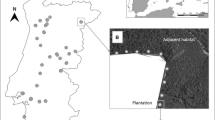Abstract
Eucalypt species are widely used around the world due to their high productivity; however there are some concerns about the invasiveness capacity of eucalypts. We assessed old seed production areas of commercial eucalypt species thought of being at risk of invasion in two places in Southeastern Brazil (Anhembi: lat: 22°28′S; long: 48°04′W; and Itatinga lat: 23°02′S; long: 48°38′W). We observed differences between places and among species. The species with the higher number of plantation stands and higher demand for seeds had more regeneration. Regeneration was recorded in only a few plots and trees and seedlings were found very close to the eucalypt stand, in sites where waste from seed harvesting is dumped. For spontaneous regeneration of eucalypts to occur there is a need for favorable environmental conditions. Such conditions may be created by human activities or natural events which suppress competition from vegetation.

Similar content being viewed by others
References
Barber HN (1965) Selection in natural plantations. Heredity 20:551–572
Booth TH, Broadhurst LM, Pinkard E, Prober SM, Dillon SK, Bush D, Young AG (2015) Native forests and climate change: Lessons from eucalypts. For Ecol Manag 347:18–29. doi:10.1016/j.foreco.2015.03.002
Callaham MA, Stanturf JA, Hammond WJ, Rockwood DL, Wenk ES, O’Brien JJ (2013) Survey to evaluate escape of Eucalyptus spp. Seedlings from plantations in southeastern USA. Internat J For Res Article ID 946374, http://dx.doi.org/10.1155/2013/946374
Calvino-Cancela M, Rubido-Bara M (2013) Invasive potential of Eucalyptus globulus: seed dispersal, seedling recruitment and survival in habitats surrounding plantations. For Ecol Manag 305:129–137. doi:10.1016/j.foreco.2013.05.037
Ferreira-Filho PJ, Wilcken CF, Neves DA, Pogetto MH, Carmo JB, Guerreiro JC, Zanuncio JC (2015) Does diatomaceous earth control leaf-cutter ants (Hymenoptera: Formicidae) in the eucalyptus plantations? J Econ Entomol. doi:10.1093/jee/tov066
Flory SL, Lorentz KA, Gordon DR, Sollenberger LE (2012) Experimental approaches for evaluating the invasion risk of biofuel crops. Environ Res Lett 7:045904
Forsyth GG, Richardson DM, Brown PJ, van Wilgen BW (2004) A rapid assessment of the invasive status of Eucalyptus species in two South African provinces. S Afr J Sci 100:75–77
Godfree R, Lepschi B, Mallinson D (2004) Ecological filtering of exotic plants in an Australian sub-alpine environment. J Veg Sci 15:227–236
Gonçalves JLM, Alvares CA, Higa AR, Silva LD, Alfenas AC, Stahl J, Ferraz SFB, Lima WP, Brancalion PHS, Hubner A, Bouillet JPD, Laclau JP, Nouvellon Y, Epron D (2013) Integrating genetic and silvicultural strategies to minimize abiotic and biotic constraints in Brazilian eucalypt plantations. For Ecol Manag 301:6–21. doi:10.1016/j.foreco.2012.12.030
Gordon DH, Flory LS, Cooper AL, Morris SK (2012) Assessing the invasion risk of eucalyptus in the United States using the Australian weed risk assessment. Int J For Res. Article ID 203768, p 7. http://dx.doi.org/10.1155/2012/203768
Harwood C (2011) New introductions—doing it right. In: Proceedings of the Conference “Developing a Eucalypt Resource for New Zealand”, 1(1993), p 10
Larcombe MJ, Silva JS, Vaillancourt RE, Potts BM (2013) Assessing the invasive potential of Eucalyptus globulus in Australia: quantification of wildling establishment from plantations. Biol Invasions 15:2763–2781. doi:10.1007/s10530-013-0492-1
Lorentz KA, Minogue PJ (2015) Exotic Eucalyptus plantations in the southeastern US: risk assessment, management and policy approaches. Biol Invasions 17:1581–1593. doi:10.1007/s10530-015-0844-0
Rejmánek M, Richardson DM (2011) Eucalypts. In: Simberloff D, Rejmánek M (eds) Encyclopedia of biological invasions. University of California Press, California, pp 203–209
Rejmánek M, Richardson DM (2013) Trees and shrubs as invasive alien species—2013 update of the global database. Divers Distrib 19:1093–1094
Richardson DM, Rejmánek M (2011) Trees and shrubs as invasive alien species—a global review. Div Distrib 17:788–809
Richardson DM, Hui C, Nunez M, Pauchard A (2014) Tree invasions: patterns, processes, challenges and opportunities. Biol Invasions 16:473–481
Ritter M, Yost J (2009) Diversity, reproduction, and potential for invasiveness of eucalyptus in California. Madroño 56:155–167. doi:10.3120/0024-9637-56.3.155
Ruthrof KX (2004) Invasion by Eucalyptus megacornuta of an urban Bushland in Southwestern Australia. Weed Technol 18:1376–1380
Silva PHM, Poggiani F, Sebbenn AM, Mori ES (2011) Can eucalyptus invade native forest fragments close to commercial stands? For Ecol Manag 261:2075–2080. doi:10.1016/j.foreco.2011.03.001
Silva PHM, Sebbenn AM, Grattapaglia D (2015) Pollen-mediated gene flow across fragmented clonal stands of hybrid eucalypts in an exotic environment. For Ecol Manag 356:293–298. doi:10.1016/j.foreco.2014.12.005
Silva PHM, Bouillet J-P, de Paula RC (2016) Assessing the invasive potential of commercial Eucalyptus species in Brazil: germination and early establishment. For Ecol Manag 374:129–135. doi:10.1016/j.foreco.2016.05.007
Silva PHM, Sebbenn AM, Grattapaglia D, Conti JL Jr (2017) Realized pollen flow and wildling establishment from a genetically modified eucalypt field trial in Southeastern Brazil. For Ecol Manag 385:161–166. doi:10.1016/j.foreco.2016.11.043
Tererai F, Gaertner M, Jacobs SM, Richardson DM (2013) Eucalyptus invasions in riparian forests: effects on native vegetation community diversity, stand structure and composition. For Ecol Manag 297: 84–93. 10.1016/j.foreco.2013.02.016
Acknowledgements
We to thank the two anonymous reviewers and the associate editor Dr. Dave Richardson for their helpful and constructive suggestions and comments in our manuscript.
Author information
Authors and Affiliations
Corresponding author
Electronic supplementary material
Below is the link to the electronic supplementary material.
Rights and permissions
About this article
Cite this article
Miolaro, L.G., Gonçalves, A.N., Mendes, J.C.T. et al. Spontaneous regeneration of eucalypts from seed production areas. Biol Invasions 19, 1733–1737 (2017). https://doi.org/10.1007/s10530-017-1397-1
Received:
Accepted:
Published:
Issue Date:
DOI: https://doi.org/10.1007/s10530-017-1397-1




